View in other NatureServe Network Field Guides
NatureServe
Montana
Utah
Wyoming
Idaho
Wisconsin
British Columbia
South Carolina
Yukon
California
New York
Pale Corydalis - Corydalis sempervirens
Other Names:
Capnoides sempervirens
State Rank Reason (see State Rank above)
Known to occur in northwest Montana from approximately a dozen recently documented (past 25 years) occurrences. Another five historical occurrences are also known. This species occurs in disturbed habitats, predominantly burned forests and it depends heavily on historical fire regimes to maintain populations. Thus, the main threat to this species' viability appears to be from fire suppression activities. Invasive weeds also threaten habitat occupied by the species.
General Description
Annual or biennial with 1 to several branched stems reaching up to 6 dm high. Foliage glabrous, with whitish wax that rubs off. Leaves with long petioles; blades pinnately divided into 3-5 pairs of leaflets that are subsequently divided 1-2 times into narrowly elliptic segments 2-5 mm wide. Flowers 3-10, borne on short, spreading to drooping stalks at the top of the branches. Sepals 2, pinkish, membranous, ca. 3 mm long, usually early deciduous. Petals 4 (2 inner; 2 outer). Corolla pinkish, yellow-tipped, 10-15 mm long. Outer petals appear to form a tube with the stalk attached near the middle; inner tubes are smaller and joined at the tips. Stamens 6, united into 2 groups. Capsules 30-45 mm long, linear, erect at maturity.
Phenology
Flowering in July.
Diagnostic Characteristics
Our only pink-flowered Corydalis is unmistakable. The introduced species Fumaria officinalis also has pink flowers, but the fruits are globose.
Species Range
Montana Range
Range Descriptions
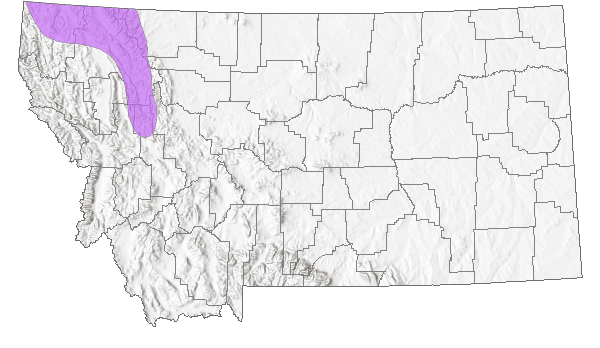
 Native
Native
Range Comments
Flathead and Glacier counties; AK to NL south to BC, MT, MB, GA (Lesica et al. 2012. Manual of Montana Vascular Plants. BRIT Press. Fort Worth, TX).
Observations in Montana Natural Heritage Program Database
Number of Observations: 60
(Click on the following maps and charts to see full sized version)
Map Help and Descriptions
Relative Density
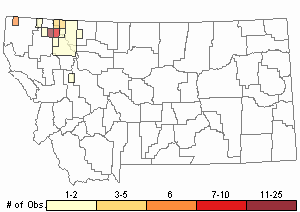
Recency
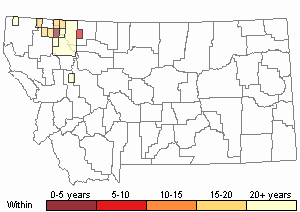
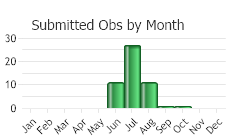
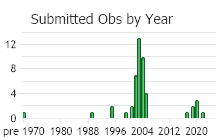
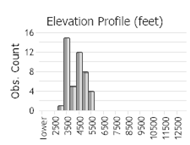 (Observations spanning multiple months or years are excluded from time charts)
(Observations spanning multiple months or years are excluded from time charts)
Habitat
Montane; rocky, disturbed or eroding soil of steep slopes in open forest, often appearing after fire (
Lesica et al. 2012. Manual of Montana Vascular Plants. BRIT Press. Fort Worth, TX).
National Vegetation Classification System Groups Associated with this Species
Forest and Woodland
Montane - Subalpine Forest and Woodland
Shrubland
Foothills - Montane Shrubland
Grassland
Montane - Subalpine Grassland
Recently Disturbed or Modified
Recently Burned
Ecology
POLLINATORS The following animal species have been reported as pollinators of this plant species or its genus where their geographic ranges overlap:
Bombus bifarius,
Bombus occidentalis, and
Bombus insularis (Macior 1974, Pyke et al. 2012, Miller-Struttmann and Galen 2014).
Stewardship Responsibility
Threats or Limiting Factors
STATE THREAT SCORE REASON
Reported threats to Montana's populations of Pale Corydalis indicate that most populations are located where competition from non-native species and disturbance from wood harvesting have negative impacts (MTNHP Threat Assessment 2021).
References
- Literature Cited AboveLegend:
 View Online Publication
View Online Publication Lesica, P., M.T. Lavin, and P.F. Stickney. 2012. Manual of Montana Vascular Plants. Fort Worth, TX: BRIT Press. viii + 771 p.
Lesica, P., M.T. Lavin, and P.F. Stickney. 2012. Manual of Montana Vascular Plants. Fort Worth, TX: BRIT Press. viii + 771 p. Macior, L.M. 1974. Pollination ecology of the Front Range of the Colorado Rocky Mountains. Melanderia 15: 1-59.
Macior, L.M. 1974. Pollination ecology of the Front Range of the Colorado Rocky Mountains. Melanderia 15: 1-59. Miller-Struttmann, N.E. and C. Galen. 2014. High-altitude multi-taskers: bumble bee food plant use broadens along an altitudinal productivity gradient. Oecologia 176:1033-1045.
Miller-Struttmann, N.E. and C. Galen. 2014. High-altitude multi-taskers: bumble bee food plant use broadens along an altitudinal productivity gradient. Oecologia 176:1033-1045. MTNHP Threat Assessment. 2021. State Threat Score Assignment and Assessment of Reported Threats from 2006 to 2021 for State-listed Vascular Plants. Botany Program, Montana Natural Heritage Program, Helena, Montana.
MTNHP Threat Assessment. 2021. State Threat Score Assignment and Assessment of Reported Threats from 2006 to 2021 for State-listed Vascular Plants. Botany Program, Montana Natural Heritage Program, Helena, Montana. Pyke, G.H., D.W. Inouye, and J.D. Thomson. 2012. Local geographic distributions of bumble bees near Crested Butte, Colorado: competition and community structure revisited. Environmental Entomology 41(6): 1332-1349.
Pyke, G.H., D.W. Inouye, and J.D. Thomson. 2012. Local geographic distributions of bumble bees near Crested Butte, Colorado: competition and community structure revisited. Environmental Entomology 41(6): 1332-1349.
- Additional ReferencesLegend:
 View Online Publication
View Online Publication
Do you know of a citation we're missing? Lesica, P., M.T. Lavin, and P.F. Stickney. 2022. Manual of Montana Vascular Plants, Second Edition. Fort Worth, TX: BRIT Press. viii + 779 p.
Lesica, P., M.T. Lavin, and P.F. Stickney. 2022. Manual of Montana Vascular Plants, Second Edition. Fort Worth, TX: BRIT Press. viii + 779 p.
- Web Search Engines for Articles on "Pale Corydalis"





